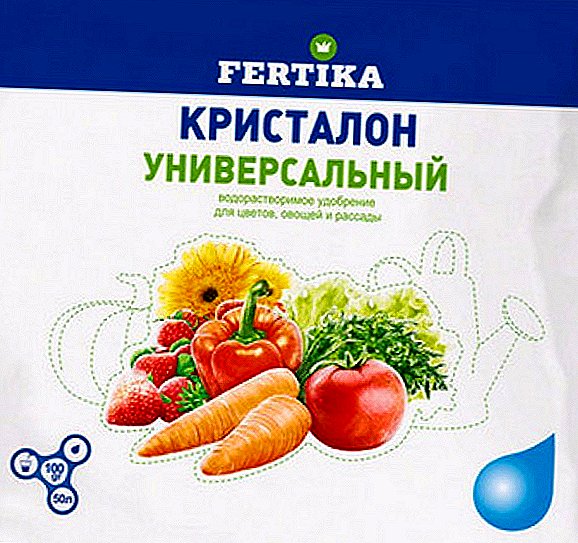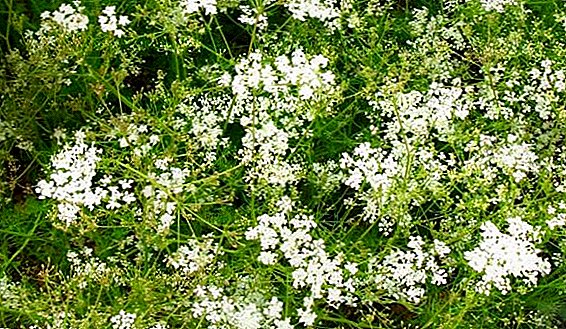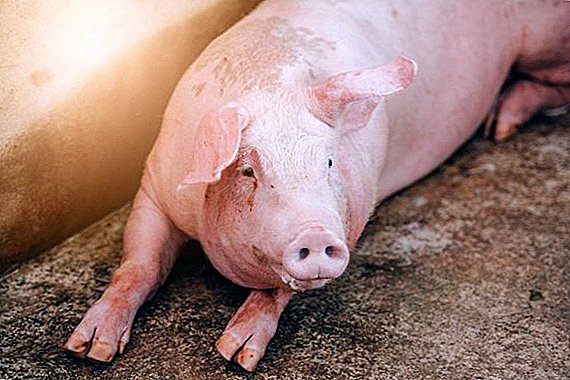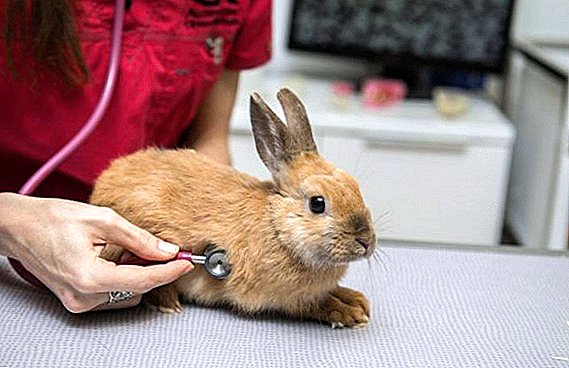 Rabbits, as you know, have not only valuable fur and dietary meat, but also not very good health. Any mistake made by the rabbit breeder in organizing the maintenance of an eared flock can have very unpleasant consequences.
Rabbits, as you know, have not only valuable fur and dietary meat, but also not very good health. Any mistake made by the rabbit breeder in organizing the maintenance of an eared flock can have very unpleasant consequences.
In order to be able to quickly respond to the very first symptoms of any of the many diseases that lie in wait for the rabbit at every step, the farmer needs to have on hand a whole arsenal of medicines. Find out what must be in such a first-aid kit.
From infectious diseases
Of course, infectious diseases of farm animals pose the greatest danger to their owner, because, striking a separate individual, they very quickly spread to the whole herd, which in the case of failure to take emergency measures often turns into a real catastrophe. For this reason, drugs against such diseases should be given increased attention.
There are a lot of infections to which rabbits are susceptible - hence the variety of medications used to fight them.
Baikox
Baycox (Baycox) is one of the most effective coccidiostatics, that is, drugs used to treat coccidiosis in rabbits and poultry. Its active ingredient - toltrazuril - not only prevents the development and reproduction of coccidia, but also kills them at the intracellular level (coccidicidal action).  Effective against all types of coccidia, including those that are resistant to other similar drugs.
Effective against all types of coccidia, including those that are resistant to other similar drugs.
Important! Even a tenfold excess of the recommended dose usually does not lead to serious side effects and poisoning, and also does not block the development of immunity to coccidiosis, which makes the drug particularly suitable for use without a doctor's prescription.
The drug is used for both prophylactic and therapeutic purposes. The need for prevention is due to the fact that coccidiosis is especially dangerous for rabbits between the ages of 15 and 60 days, while toltrazuril is able to prevent further development of the disease in its early stages, when its first signs (bloody diarrhea) have not yet appeared.
Baikoks 2.5% is diluted with water in the proportion of 7 mg per 1 kg of live weight and given to young animals instead of drinking. For simplicity, a dosage of 1 ml per 10 liters of water is allowed - in this case, the little rabbit, drinking the usual amount of liquid, will receive the necessary portion of the medicine. 5% drug is soldered to each individual individually (poured into the mouth) without prior dilution.  Bikecox for rabbits bred in a drinking bowl For the treatment of adults, 20 ml of Baycox should be used per 10 liters of water. The treatment period lasts 2-3 days, for a prophylactic course two days are enough. However, if the disease is severe, the treatment period lasts up to five days or longer, until the symptoms of coccidiosis disappear completely.
Bikecox for rabbits bred in a drinking bowl For the treatment of adults, 20 ml of Baycox should be used per 10 liters of water. The treatment period lasts 2-3 days, for a prophylactic course two days are enough. However, if the disease is severe, the treatment period lasts up to five days or longer, until the symptoms of coccidiosis disappear completely.
Phthalazole
Ftalazol is another drug effective for the treatment of coccidiosis. Its active ingredient is phthalylsulfathiazole, a member of the sulfonamide group, antimicrobial agents. The compound has activity against many bacteria, both gram-positive and gram-negative, including various E. coli. For this reason, Phthalazole makes sense to use in the case when the exact diagnosis is not completely clear.
The drug is diluted with water and allowed to drink to animals twice a day. The dosage used per 1 kg of weight is usually 20-30 mg. With diagnosed coccidiosis, treatment is carried out consisting of two five-day courses with a break of 5 days. During the first two doses, a dosage of 20 mg per kg of weight is used, then the amount of Phthalazole is reduced by half.
Learn how to identify and treat coccidiosis in rabbits.
Norsulfazole
Norsulfazol - antimicrobial drug with sulfathiazole as an active ingredient. It has a wide spectrum of action; particularly effective in:

- coccidiosis;
- Rodentioze;
- listeriosis;
- intestinal yersiniosis;
- endometritis;
- enteritis;
- enterotoxemia;
- dysentery;
- hemorrhagic septicemia;
- rhinitis;
- respiratory infections of a bacterial nature.
Important! To increase the therapeutic effect of Ftalazol and Norsulfazol can be combined: during the first course to use one drug, for the next - the second. Also, in parallel with these means, it is useful for cats to give iodine and, if necessary, antibiotics.
With an unspecified diagnosis, a single dose of the drug is 30-40 mg per 1 kg of rabbit weight, but if the condition is severe, the dose is increased to 50 mg, and the number of doses per day - up to two or even three times. The course of treatment can be extended to 6 days.
If the drug is used for prophylactic purposes, half the dosage is taken, and the intake period is from three to five days.
Furazolidone
Furazolidone is an antimicrobial drug commonly used to treat all of the same coccidiosis, as well as salmonellosis, endometritis, hemorrhagic septicemia, rhinitis, and some other infectious diseases. The undoubted advantage of the drug is the low probability of the formation of bacterial strains resistant to it. The therapeutic effect is enhanced in the case of parallel administration of antibacterial drugs, usually terramycin is used for this purpose.  In addition, the drug is available in the form of an ointment for local use, in particular for the treatment of mastitis, burns, inflamed wounds and even purulent conjunctivitis.
In addition, the drug is available in the form of an ointment for local use, in particular for the treatment of mastitis, burns, inflamed wounds and even purulent conjunctivitis.
Learn how to help a rabbit with rhinitis and conjunctivitis.
The treatment course is from six to eight days with twice daily intake. The dose is calculated on the basis of 30 ml of the drug per 1 kg of rabbit weight. The prophylactic dose is ½ of the treatment.
Sulfadimethoxine
Sulfadimetoksin refers to a broad-spectrum antimicrobial agents (the name of the active substance coincides with the trade name). The therapeutic effect after taking it lasts up to a day, and sometimes up to 48 hours, which makes the medicine especially attractive to the farmer. Like furazolidone, sulfadimethoxin enhances its action when antibiotics are used together, but trimethoprim is usually prescribed in this case.  The drug is effective in treating infectious diseases such as:
The drug is effective in treating infectious diseases such as:
- coccidiosis;
- salmonellosis;
- hemorrhagic septicemia;
- dysentery;
- diseases caused by bacteria of the Staphylococcaceae family and many other parasites.
Check out the common diseases of the ears and eyes in rabbits.
Metronidazole
Metronidazole is a very popular drug in poultry farming and rabbit breeding, which is active against such types of protozoan parasites as amoebas, trichomonads, giardia, balantidia, histomonads and some other anaerobes (both gram-positive and gram-negative).
 The drug is widely used to treat:
The drug is widely used to treat:
- coccidiosis;
- enterohepatitis;
- enteritis;
- trichomoniasis;
- salmonellosis;
- colibacillosis;
- Giardiasis, etc.
The course of treatment is usually 2-3 days, during which time the remedy is drunk to animals in a dosage at the rate of 40-50 mg per 1 kg of weight.
If it is necessary to provide individual treatment of the affected individual, injections of metronidazole are used (1 cubic cm per 1 kg of weight). A total of 2 shots are taken with a break of 48 hours.
Dithrim
Ditrim, in contrast to the preparations described above, includes not one, but two active substances that successfully complement each other: one of them is the already mentioned antibiotic trimethoprim (1/6 part), the second is sulfadimezin, a drug from the group of sulfonamides. The drug has a pronounced bacteriostatic action and is effective in the treatment of coccidiosis, as well as other bacterial infections affecting the gastrointestinal tract, respiratory organs, urinary tract, and also the reproductive system of rabbits.  The standard dosage is 0.1 ml per 1 kg of mass when used as injections, and the solution is based on 1 ml of the medicine per 1 liter of water - when taken orally. Injections are made daily for 3-7 days, in severe cases, the number of injections is increased to two times a day for the first 2 or 3 days.
The standard dosage is 0.1 ml per 1 kg of mass when used as injections, and the solution is based on 1 ml of the medicine per 1 liter of water - when taken orally. Injections are made daily for 3-7 days, in severe cases, the number of injections is increased to two times a day for the first 2 or 3 days.
Important! Ditrim's injection is quite painful, so rabbits tolerate it not very well, and edema often occurs at the injection site.
Ditrim preventive feeding is carried out for three days every month. Therapeutic course - 5 days in a row, or 3 and 3 more days with a break of 2 days.
Sulfapyridazine
Sulfapyridazine, along with sulfadimethoxin, phthalazole and norsulfazole, belongs to the antimicrobial drugs of the sulfanilamide group. Active against many gram-positive and gram-negative bacteria. Effective against bacterial infectious diseases affecting:
- gastrointestinal tract;
- Airways;
- urinary system;
- gallbladder.
 In particular, it is used to treat:
In particular, it is used to treat:
- coccidiosis;
- colibacillosis;
- salmonellosis;
- gastroenteritis;
- hemorrhagic septicemia;
- mastitis
Important! In order to avoid side effects that sometimes occur when using sulfapyridazine, during the period of the therapeutic or prophylactic course, the rabbits need to be given a lot of liquid with a high alkali content.
Brovitokoktsid
Brovitokoktsid has a narrower spectrum of action compared with most of the above drugs, but is a very effective coccidiostatic. Its active ingredient - amprolium hydrochloride - in addition to direct effects on coccidia, also very well promotes the healing of wounds that appear in the gastrointestinal tract of an animal due to the presence of parasites in it. This compound is a synthetic analogue of vitamin B1. In addition, vitamin A and vikasol, which improve the condition of the intestinal mucosa and prevent the formation of hemorrhages, are part of the browvocaccid.  Brovitokoktsid is most active against three types of coccidia - Eimeria stiedae, Eimeria perfonas and Eimeria magna, that is, those that most often parasitize in the body of the rabbit. Like Baycox, Brovitokoktsid can be used for prophylactic and therapeutic purposes. In the latter case, the youngsters are poured into the drinkers a solution prepared at the rate of 20-25 mg of Brovitacoccide per 1 liter of water, the course of treatment lasts 4-5 days. For prophylaxis, the same dose of the drug is given for 1-2 days.
Brovitokoktsid is most active against three types of coccidia - Eimeria stiedae, Eimeria perfonas and Eimeria magna, that is, those that most often parasitize in the body of the rabbit. Like Baycox, Brovitokoktsid can be used for prophylactic and therapeutic purposes. In the latter case, the youngsters are poured into the drinkers a solution prepared at the rate of 20-25 mg of Brovitacoccide per 1 liter of water, the course of treatment lasts 4-5 days. For prophylaxis, the same dose of the drug is given for 1-2 days.
Solikox
Another well-known remedy for the treatment of coccidiosis in rabbits is Solikoks. Its effectiveness extends to all types of parasites that are dangerous for an eared herd. Like Baikoks, Solikoks does not belong to highly toxic drugs, and its overdose, even very significant, practically does not threaten the animal. For the same reason, the drug can be used in combination with other drugs, in the heat and at high humidity, as well as in relation to weakened individuals.  The daily therapeutic dose of the drug is 40 ml per 1 kg of live weight, the therapeutic course is 6 days or two times for 5 days with a 4-day break.
The daily therapeutic dose of the drug is 40 ml per 1 kg of live weight, the therapeutic course is 6 days or two times for 5 days with a 4-day break.
Important! Meat of rabbits taking Solikox treatment can be eaten without any restrictions.
Ekmonovocillin
All of the above drugs belonged to antimicrobial agents that are not antibiotics. In contrast, Ekmonovocillin is a combination drug that includes the penicillin antibiotic benzylpenicillin, as well as ecmoline, a natural antibiotic substance.
Such a composition of the drug makes it very effective in the treatment of respiratory diseases of a bacterial nature, first of all, infectious rhinitis (rhinitis) at an early stage of infection (in difficult cases it is necessary to use stronger antibiotics).  Another feature of Ekmonovocillin is that it is used not orally, but locally, by instillation into the nose, which is a rare exception for antibacterial drugs. 1% Ecmonovocillin is diluted with two parts of saline or boiled water and the resulting mixture is instilled into each nostril of a cold animal 5-7 drops daily until therapeutic effect is reached.
Another feature of Ekmonovocillin is that it is used not orally, but locally, by instillation into the nose, which is a rare exception for antibacterial drugs. 1% Ecmonovocillin is diluted with two parts of saline or boiled water and the resulting mixture is instilled into each nostril of a cold animal 5-7 drops daily until therapeutic effect is reached.
In parallel, you can use intramuscular injections Ekmonovotsillina - 1 "cube" for every kilogram of body weight. One shot is placed every three days.
Did you know? If in veterinary medicine, in particular in rabbit breeding, Ekmonovocillin is used for the treatment of "innocent" rhinitis, then in traditional medicine this drug is one of the main means to combat syphilis.
Injections are also effective for pneumonia, but in this case, the dose is increased to 2 "cubes" per 1 kg of weight and put injections daily for 3-4 days.
Hemomycin
Hemomitsin is also a broad-spectrum antibiotic used by rabbit breeders to treat infectious rhinitis in a fluffy herd. The active ingredient is azithromycin (macrolide, an erythromycin derivative). Hemomitsin is active against such gram-positive streptococci:
- pyogenic streptococcus;
- Pneumococcus;
- Staphylococcus aureus;
- hemophilic wand.
 The drug helps to defeat the causative agents of diphtheria and whooping cough, and also adversely affects:
The drug helps to defeat the causative agents of diphtheria and whooping cough, and also adversely affects:
- listeria;
- legionella;
- moraxella;
- spirochete;
- chlamydia;
- campilbaters;
- microplasma;
- ureaplasma and some other anaerobic bacteria.
However, due to the uncontrolled and not always justified use of antibacterial drugs in recent years, the number of strains of Hemomycin-resistant bacteria has been steadily increasing.  For the treatment of rabbits 1 tablet Hemomitsina diluted in 8 ml of water. The resulting solution is a dose calculated for four animals (the medicine is individually poured into the mouth of each animal, for convenience it is recommended to use a disposable syringe without a needle). The treatment is carried out with a single daily dose for 3-5 days.
For the treatment of rabbits 1 tablet Hemomitsina diluted in 8 ml of water. The resulting solution is a dose calculated for four animals (the medicine is individually poured into the mouth of each animal, for convenience it is recommended to use a disposable syringe without a needle). The treatment is carried out with a single daily dose for 3-5 days.
Furacilin
Furacilin is a drug of the sulfonamide group, an antiseptic that is not an antibiotic. Nevertheless, it is quite often used for the local treatment of infectious rhinitis in rabbits.
Important! Furacilin - a drug of low therapeutic efficacy, it should be used only to eliminate the symptoms of the disease (relief of nasal breathing in a rabbit). In severe forms of the disease use drugs with a stronger effect.
Furacilin 1% is mixed with boiled water at the rate of 10 g of medicine per 1 l of water. The resulting supersaturated solution is thoroughly shaken and instilled in the nose to the animal 8-10 drops into each nostril. The course of treatment is 10-14 days, however, the drug is low toxic, so overdose is not dangerous. 
Biomitsin
Biomitsin - a broad-spectrum antibiotic (tetracycline group). It is active against many pathogenic microorganisms, but in rabbit breeding it is most often used in the form of intramuscular injections for the treatment of pasteurellosis. In respiratory diseases of the catarrhal nature, Biomitsin manifests itself worse than in case of problems with the digestive system, but is sometimes used against them. In addition, it is included in the group of substances that unscrupulous farmers still use to prevent and accelerate weight gain by animals.
Therapeutic dose of Biomitsin is 0.02-0.025 mg per 1 kg of live weight of the rabbit. The course of treatment, depending on the clinical picture, is 3-5 days, the number of injections is two per day with a break of at least 8 hours.
Read the list of diseases of rabbits that are dangerous to humans.
Terramycin
Terramycin, like Biomitsin, belongs to the tetracycline group of antibiotics and exhibits a wide spectrum of action: it affects bacteriostatically many gram-positive and gram-negative microbes. Among them:

- streptococci;
- staphylococcus;
- salmonella;
- E. coli;
- pasteurella multitotsida;
- clostridia;
- actinobacteria;
- mycoplasma;
- rickettsia;
- chlamydia;
- protea.
Gamavit
This is not a medicine, but a vitamin supplement used to strengthen the immunity of animals, including those affected by an infectious disease of a bacterial or viral nature. In addition to vitamins, the drug contains a set of amino acids and minerals that are important for rabbits, which makes it possible to give it to even newborn baby rabbits, especially those devoid of mother's milk - the so-called "artificialis".  Gamavit, along with antibiotics and other drugs, is also used when animal ticks are detected in animals, myxomatosis, poisoning, stress, and obstetric care - in short, cases of use of Gamavit are extensive and diverse. The dosage and the course of administration depend on the goal set for the farmer (treatment, prophylaxis, etc.), but usually it is a question of 1 "cube" per 1 kg of body weight. Most often, Gamavit is injected intramuscularly (in the thigh) or subcutaneously (in the withers).
Gamavit, along with antibiotics and other drugs, is also used when animal ticks are detected in animals, myxomatosis, poisoning, stress, and obstetric care - in short, cases of use of Gamavit are extensive and diverse. The dosage and the course of administration depend on the goal set for the farmer (treatment, prophylaxis, etc.), but usually it is a question of 1 "cube" per 1 kg of body weight. Most often, Gamavit is injected intramuscularly (in the thigh) or subcutaneously (in the withers).
Read more about the use of Gamavita for rabbits.
Fosprenil
Fosprenil is a preparation made from pine needles (the active ingredient is polyprenol disodium phosphate). Often referred to as an antiviral drug, but in reality it is, at best, a general tonic remedy, or speaking directly, an agent with unproven efficacy.  Fosprenil is used orally, topically (for example, for rubbing eyes with conjunctivitis) or in the form of injections (subcutaneous, intramuscular, intravenous). The doctor prescribes the dosage and the course, and each doctor can decide for himself whether to carry out such treatment.
Fosprenil is used orally, topically (for example, for rubbing eyes with conjunctivitis) or in the form of injections (subcutaneous, intramuscular, intravenous). The doctor prescribes the dosage and the course, and each doctor can decide for himself whether to carry out such treatment.
Baytril
Baytril is an antibiotic of new generation. The active ingredient in it is enrofloxacin (a group of fluoroquinolones). This is a broad-spectrum substance that is active against such gram-positive and gram-negative microorganisms:
- E. coli;
- hemophilus bacillus;
- Pseudomonas aeruginosa;
- pasteurella multitotsida;
- salmonella;
- staphylococcus;
- streptococci;
- clostridia;
- Bordetella bronchiseptic;
- campylobacter;
- Corynebacterium;
- Proteus;
- mycoplasma.
We recommend to know what to do if the rabbit is lying on its stomach or side and does not get up.
Baytril, therefore, is prescribed to treat a huge number of infectious diseases. The course of treatment and the dosage of the antibiotic should always be determined by the doctor, but usually the drug is administered as an injection for five days.  A dose of 5% Baytril in a volume of 5 mg is used per animal. In the case of purchasing the drug in another concentration, the dosage is calculated accordingly.
A dose of 5% Baytril in a volume of 5 mg is used per animal. In the case of purchasing the drug in another concentration, the dosage is calculated accordingly.
Ringer's solution
Ringer's solution is a physiological solution, which includes several components in a clearly defined concentration. In particular, these are inorganic salts - chlorides of potassium, calcium and sodium, sodium bicarbonate.
 The main purpose of the drug is oral dehydration (prevention of dehydration). In rabbit breeding it is used as an aid in:
The main purpose of the drug is oral dehydration (prevention of dehydration). In rabbit breeding it is used as an aid in:
- myxomatosis;
- poisoning;
- intestinal disorders;
- other diseases of the gastrointestinal tract.
- bleeding;
- burns;
- frostbite;
- stress and other.
For the prevention of myxomatosis in rabbits, the Rabbiwak V vaccine is used.
Bitillin
Bicillin belongs to the group of penicillin antibiotics and is one of the few drugs in this series that can be used to treat rabbits.
Bicillin should be administered subcutaneously. The course of treatment is usually very long - from one to two months. Injections, depending on the clinical picture, are placed once every 2-3 days. A single dose per 1 kg of mass ranges from 30 to 70 thousand IU. The antibiotic is diluted with saline, the optimal injection volume for the injection is one and a half "cubes". 
From bloating
The digestive system in rabbits is very tender and sensitive, and therefore various gastrointestinal disorders in these animals occur quite often and represent a serious problem for the farmer. It is for this reason that in the first-aid kit of any rabbit breeder there must be preparations that allow to adjust the digestion and eliminate such an unpleasant symptom of a disruption in his work, like bloating.
Activated carbon
Activated carbon is one of the first sorbents discovered by man. Its advantages as an ambulance for various intoxications can still be called unsurpassed without exaggeration. The unconditional advantages of the substance should be attributed to its price - the drug costs literally a penny.
Did you know? Activated carbon is the only enterosorbent that the World Health Organization recommends using during pregnancy, breastfeeding, as well as in the treatment of poisoning in children.
However, in veterinary medicine, this drug is used quite widely. So, in case of suspicion of poisoning, rabbits are given one crushed and diluted in water tablet per 1 kg of body weight (the drug is injected directly into the mouth with an insulin or a conventional syringe without a needle). It does not interfere with such a procedure in the case of excessive gas formation in the intestines of the animal, which gives him serious inconvenience. 
Tympanol
If activated carbon is a “pure” sorbent (its action is based on the ability of a substance to bind, “stick to itself” all substances in the body and then remove them from the body), then Tympanol acts differently. The drug contains polydimethylsiloxane, also known as food additive E900, polyvinyl alcohol, lactic acid, as well as vegetable tinctures (wormwood and hellebore). Polydimethylsiloxane reduces the surface tension of gas bubbles in the intestine, which contributes to their destruction and hampers the formation of new ones. In other words, TImpanol is a remedy for bloating.
Medicinal herbs at the same time have a general strengthening effect on the intestine, improve its peristalsis, reduce muscle tone, thus contributing to the speedy removal of the contents out.  Tympanol is given to rabbits suffering from bloating as a result of overeating food that is prone to mild fermentation (mainly green and succulent fodder). The emulsion is diluted with water in the ratio of 1:10 or 1:15 and injected into the stomach of rabbits with the help of a bottle with a nipple or a food probe.
Tympanol is given to rabbits suffering from bloating as a result of overeating food that is prone to mild fermentation (mainly green and succulent fodder). The emulsion is diluted with water in the ratio of 1:10 or 1:15 and injected into the stomach of rabbits with the help of a bottle with a nipple or a food probe.
Simethicone
Simethicone is prescribed to rabbits when the bowels stop working (the so-called gastrointestinal stasis). The drug helps to relieve pain caused by flatulence. The product is safe and non-toxic, so it can be given to animals every hour, 1-2 ml three times, and then, as the state stabilizes, 1 ml every 3 hours. In parallel, the use of any medications according to indications is allowed (Simethicone is neutral and does not affect the pharmacological properties of other drugs). According to the principle of action, Simethicone is similar to Tympanol.
From worms
Helminths are another problem that is relevant to rabbits. These parasites can provoke the development of many associated diseases and even lead to the death of the animal, therefore, in no way can we ignore the appearance of worms symptoms, especially since it is not so difficult to fight them with the help of modern medicines. 
Important! Preventive deworming of rabbit herd is recommended at least once in 3 months.
Albendazole
Albendazole is a broad-spectrum antihelminthic drug that can cope not only with adult worms, but also with their eggs and larvae. The activity of the drug extends to trematodes, cestodes, nematodes and other protozoa, as well as capillaries, echinococci, gnatostom, living in tissues.
Indications for the use of albendazole is the treatment and prevention of:
- ascariasis;
- strongylose;
- moniezioza;
- dicroceliosis;
- ascariasis;
- esophagostomy disease;
- nematodosis;
- habertiosis;
- dictyocaulosis;
- bunostomosis;
- fascioliasis;
- paramphomatosis;
- heterosis;
- cooperative disease.
 The drug is given once at a dosage of 15 mg per 1 kg of live weight. The easiest way to mix it with food. However, in particularly difficult cases, animals are treated with this drug for 4-5 days (the veterinarian prescribes the treatment regimen and dosage).
The drug is given once at a dosage of 15 mg per 1 kg of live weight. The easiest way to mix it with food. However, in particularly difficult cases, animals are treated with this drug for 4-5 days (the veterinarian prescribes the treatment regimen and dosage).
Shustrik
Shustrik is another anthelmintic drug intended primarily for the prevention and treatment of nematodiroses and cestodoses in rabbits. Its active ingredient - fenbendazol - kills nematodes at the cellular level, and causes paralysis in cestodes. The positive side of the drug should include its low toxicity and almost complete safety for the rabbit itself.
Did you know? The roundworm female is able to lay two hundred forty thousand eggs for 24 hours.
It is applied once at a dosage of 1 ml per 1 kg of live weight. If it is necessary to de-worming the whole herd, the drug is mixed with food in a volume of 20 ml per 1 kg of feed, and rabbits should not receive any other food on the day of reception. 
From ear mite
Unfortunately, parasites can affect not only internal, but also external organs of rabbits. In the first place, the enormous ears of animals suffer from this misfortune. The most common problem of this kind is the ear mite, and therefore the farmer should definitely stock in advance at least one remedy for psoroptes (ear scabies caused by the mite).
Acrodex
Acrodex is a drug containing two active ingredients. The first of them has insecticidal (kills harmful insects), the second - acaricidal action (kills ticks). The aerosol is applied to the inner side of the animal's ear, after which it is necessary to gently massage the ear, not forgetting to protect the hands with rubber gloves. The procedure should be repeated twice with an interval of 8-12 days, which will allow to get rid of both adult ticks and their larvae and eggs, which they have time to lay.
Did you know? Contrary to popular misconception, ticks are not insects. Ticks belong to arthropods, detachment - arachnids.
Psoroptol
Psoroptol contains birch tar and ethyl acetate as the active ingredient. Available in aerosol form. The treatment method is completely analogous to the use of Akrodex.  You should not purchase all of the above drugs and store them in your first-aid kit. First, medicines have a limited duration, and after two or three years, its contents can simply be sent to the dustbin.
You should not purchase all of the above drugs and store them in your first-aid kit. First, medicines have a limited duration, and after two or three years, its contents can simply be sent to the dustbin.
We recommend to learn how to identify and get rid of the ear mite and worms in rabbits.
Secondly, it is easy to see that many of the drugs described have similar characteristics. Therefore, a rabbit grower should be flexible. In the first-aid kit it is necessary to have a coccidiostatic agent, a broad-spectrum antimicrobial agent (antiseptic) and an antibiotic. In addition, you should keep in stock sorbents, funds from intestinal disorders, worms and ear mites. Thus, having correctly selected 4-5 drugs, the farmer can be sure that he will always be able to provide emergency assistance to his pets in a critical situation.












